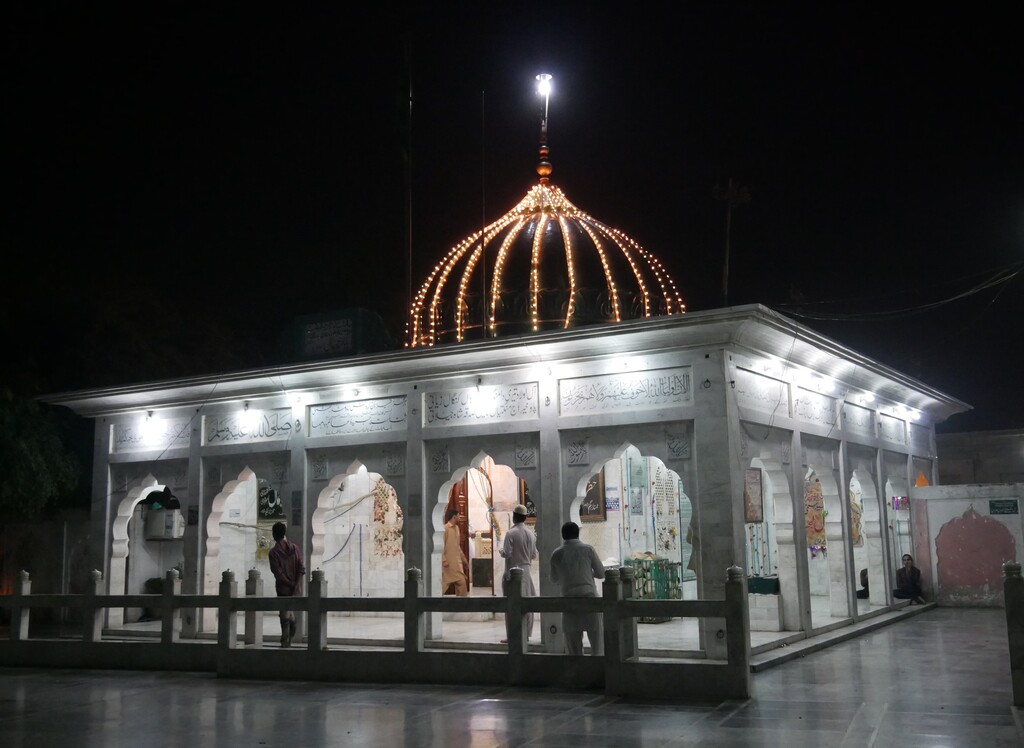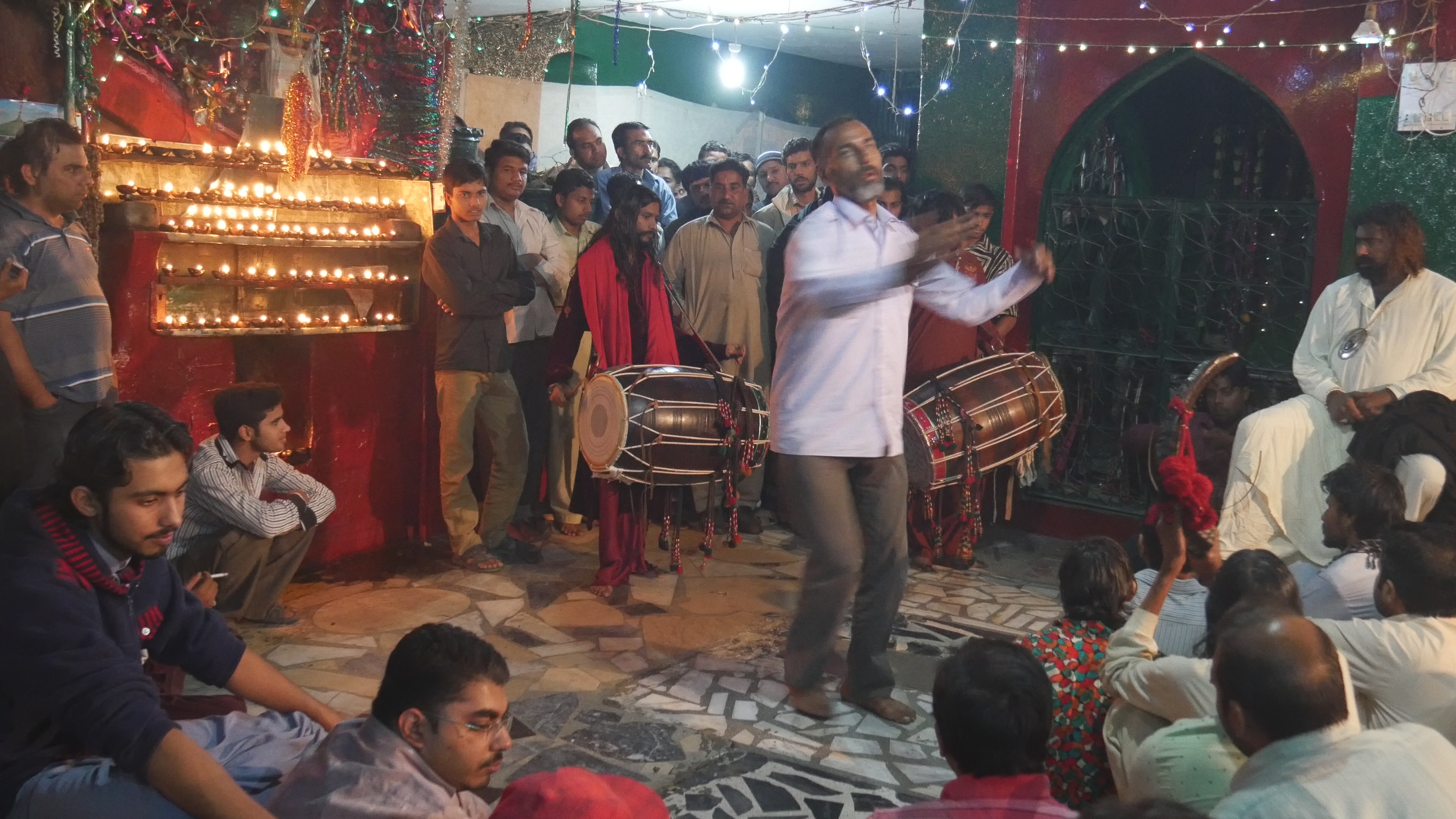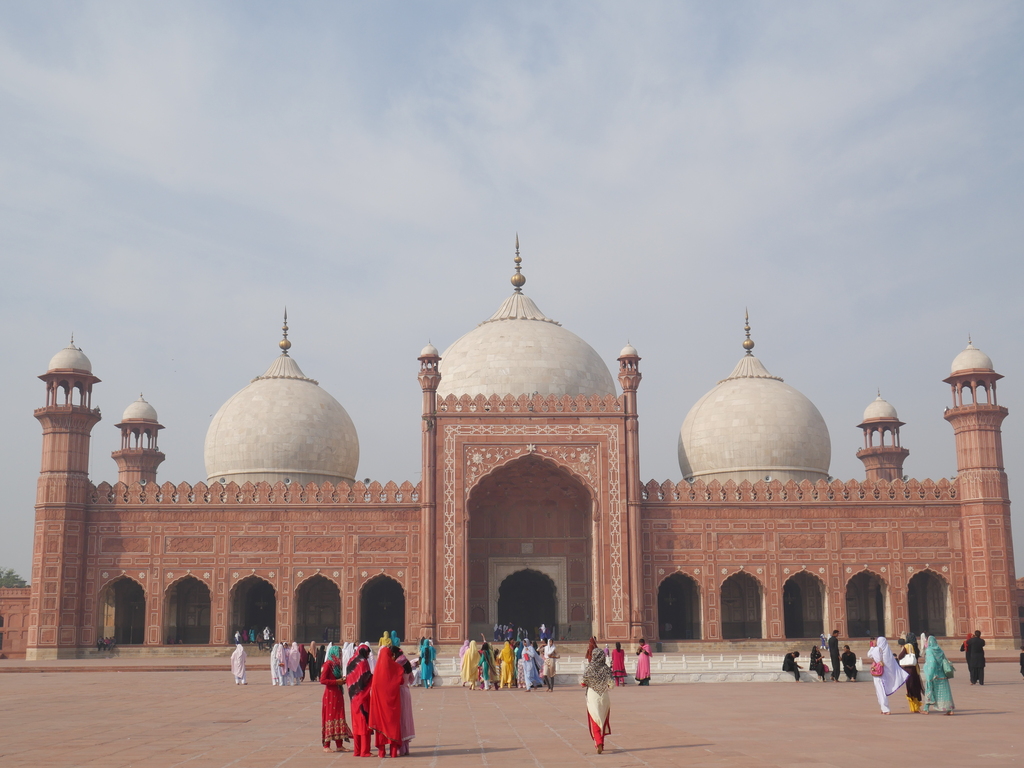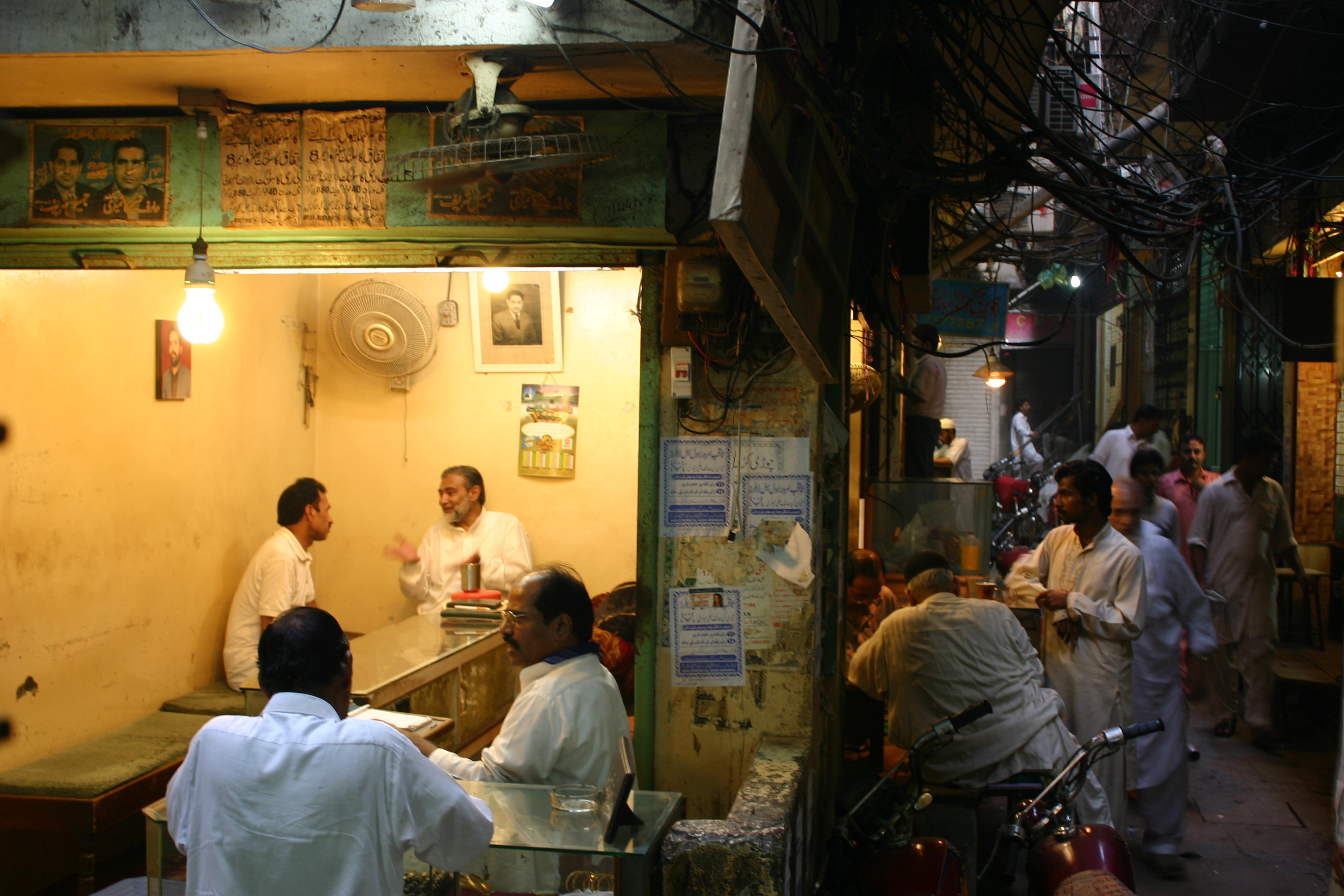The land of the Sufis

"Ali Haidaaar!" The drawn-out words of praise resonate across the inner courtyard of the Shrine of Shah Jamal. For a moment, the deafening drumbeats that punctuate the incense-drenched air fall silent. These shouts of praise for Ali drive the dancers and observers at the Sufi shrine in the old quarter of Lahore to ever greater heights of ecstasy. In Islamic mysticism, Ali is considered the custodian of wisdom and the source of most Sufi chains of initiation. After all, the Prophet Muhammad passed on the esoteric secrets of the tradition to Ali before his death.
Swaying gently, a gaunt malang (dervish) teeters across the courtyard, his wavy hair slick and shining with oil. Around his neck hangs a chain with colourful plastic flowers. The intoxicated dancer's eyes are half open, giving the impression that his mind is on another plane. In his hand, he holds a long horn into which he blows from time to time. Beside him, another dervish, dressed in a poppy-red tunic, shakes the long locks of his hair in the night air.
The dance movements are steered by an ensemble of three drummers. They beat the massive drums with wooden sticks, at times ponderously, at times more quickly and then in rapid salvos. The drums they are playing are called dhol and can be heard every Thursday evening at the Shrine of Baba Shah Jamal, a Sufi saint from the sixteenth century, about whom very little information remains extant.
The shrine of Baba Shah Jamal is known across this city of 14 million people for the wild evenings that take place there. Here, the ecstasy of the malang dancers finds free and unfettered expression. In the folk Islam of South Asia, malang is the word for a kind of mystic vagabond who refuses to submit to the laws of society and – in the eyes of the religiously orthodox – behaves in a reprehensible manner.

Between haram and halal
Breaking conventions and rules of behaviour, crossing back and forth across the boundary between haram and halal, is a recurring theme in Sufi traditions from Europe to Eastern Asia, whether it be the meczup, the divine lunatics on the streets of Istanbul, or the itinerant dervishes of Persia. The malamatiya was a mystic movement in the Islamic Middle Ages whose adherents intentionally exposed themselves to the criticism and vilification of the general public in order to hone their sense of self, for example by taking a nap at the entrance to mosques at prayer times, or drinking wine in public places.
Hardly any country in the geographical region generally termed the "Islamic world" is as strongly influenced by the traditions of Sufism as Pakistan. From the mountain valleys of the Himalayas in the north to the desert regions of Balochistan, from the Pashtun tribal homelands on the Afghan border to the lowlands of the Punjab, Sufi folk culture has had a profound influence on the religious life of Pakistanis.
This is particularly true of Lahore, Pakistan's cultural capital and the capital of the Pakistani province of Punjab. Alongside the seat of government, Islamabad, and the economic hub that is Karachi, Lahore is one of the three most important urban centres in the country. It is peppered with Sufi shrines and embedded in a cultural landscape that is distinguished by the architectural heritage of the Mughal dynasty, just like Delhi's old quarter, 425 kilometres away as the crow flies. Punjab means "the land of five waters" and takes its name from the five rivers that flow through the region, which has been divided up between Pakistan and India since 1947.
Sufism has also manifested itself in Pakistan's turbulent political arena on a number of occasions in the past. For example, some of the political Islamist movements have developed out of Sufi orders. Pakistan's last prime minister, Imran Khan, who was voted out of office by a parliamentary vote of no confidence in April 2022, married the Sufi teacher Bushra Bibi from Pakpattan just before taking office, after years of studying mystic Islam.

This small town in the Punjab is famous for the Shrine of Baba Farid, one of the most important Sufi mystics on the Indo-Pakistani subcontinent. Baba Farid belonged to the Chishti order, which is known for its fostering of devotional music as a spiritual practice.
Pakistan's reputation as a breeding ground for intolerance and terrorism
For several decades now, Pakistan has been dogged by its reputation as a breeding ground for intolerance and terrorism. In the 1980s, the country became a training ground for the Mujahideen when under the leadership of military dictator Zia ul-Haq and with the generous financial support of the United States and Saudi Arabia, holy warriors were ideologically drilled for the fight against the Soviets. The seed of a fundamentalist brand of Islam, which has virtually nothing in common with the syncretistic tradition of South Asia, continues to plague Pakistan to this day and was further nourished by the rise of the Taliban in Afghanistan.
Over and over again in recent years, Sufis in Pakistan have been targeted by violent extremists – whether in the form of attacks on holy shrines or targeted killings such as the murder of the qawwali singer Amjad Farid Sabri, who was shot dead in Karachi in 2016 on his way home from a television appearance. In 2017, the so-called "Islamic State" killed 90 and injured over 300 in an attack on the shrine of the iconic saint Lal Shahbaz Qalandar in Sindh.
Such attacks target the syncretistic culture of Sufi poetry, music and dance, which seeks to give believers a direct experience of God beyond religious dogmas and laws. In the eyes of the extremists, the veneration of saints is idolatry, one of the greatest sins in Islam. Instead, the self-declared custodians of Islam subscribe to a puritanical orthodoxy such as that preached by the Wahhabis of Saudi Arabia and which, powered by billions of petrodollars, has ideologically poisoned religious life in many Islamic countries.
Islam spread by itinerant preachers and Sufi saints
Nevertheless, even though the influence of hardliners has steadily increased over the years, mystic piety remains deeply anchored in religious practice in Pakistan. It was itinerant preachers and Sufi saints who spread Islam across the Indo-Pakistani subcontinent in the Middle Ages. Their charisma, which was pervaded by the energy of God, and the Islamic promise of equality before the one God were well received in a society shaped by the caste system.
In South Asia, Muslims integrated existing traditions into their own faith: Hindu and Buddhist legends of miracles were transferred to Muslim saints, rituals such as the presentation of flowers or offerings, which are practiced in the Hindu temples of India, became part of folk Islam.

Right beside the courtyard with the malang dancers is a graveyard where small groups of men are sitting and talking in the darkness. The sweet scent of marijuana hangs in the air. Away from the rhythmic drumming in the courtyard and surrounded by graves, a quartet of musicians – one playing the harmonium, one playing the tabla, and two singing – launch into a classical hymn from the qawwali repertoire. In a performance laden with emotion, the lyrics ring out beneath the night sky; bystanders join in the chorus.
The poem "Sason Ki Mala Pe", which was once immortalised by the voice of the great qawwali maestro Nusrat Fateh Ali Khan, is evidence of the religion-spanning spirituality that is such a thorn in the side of the fundamentalists. Originally, it was the Indian mystic Mirabai who composed the ode as a love song to the Hindu god Krishna in the fifteenth century: "With every breath, I sing the name of my beloved / I know my heart, and God knows my beloved's heart. / This is my salutation and my prayer. / One lover went into the temple, another into the mosque, but for me – submerged in the love of God – the two were one."
Mirabai's poetry dates from an age characterised by a fruitful exchange between Hindu and Muslim mystics. In view of the growing extremism in religious life in Pakistan and the persecution of minorities – today, it is estimated that less than two percent of the Pakistani population are Hindu – this golden age seems light years away from our own.
In India too, the politics of the Hindu nationalists under Prime Minister Narendra Modi have created a situation where Islamic cultural assets are systematically being suppressed, while Muslims live in an atmosphere of fear, afraid of hostility, mob attacks and even the destruction of their homes.
Faced with general polarisation within the societies of South Asia, it seems there is very little the teachings of Sufism, which seek to transform human egos, can do. In addition, capitalism and the politicisation of many Sufi orders have led to the true core of the mystic teachings being watered down.
This, it would seem, was also a problem in the Middle Ages: as far back as the eleventh century, the great Ali Hujwiri, who is considered the patron saint of Lahore, quoted one of his predecessors in his mystic classic The Revelation of the Veiled as follows: "Today, Sufism is a name without a reality, but formerly it was a reality without a name".
© Qantara.de 2022
Translated from the German by Aingeal Flanagan